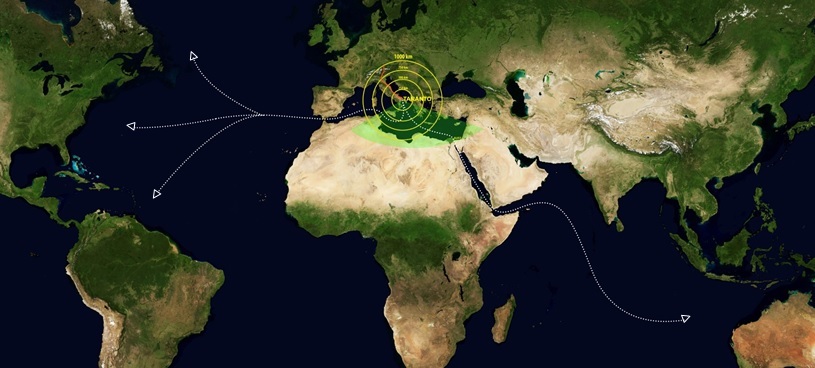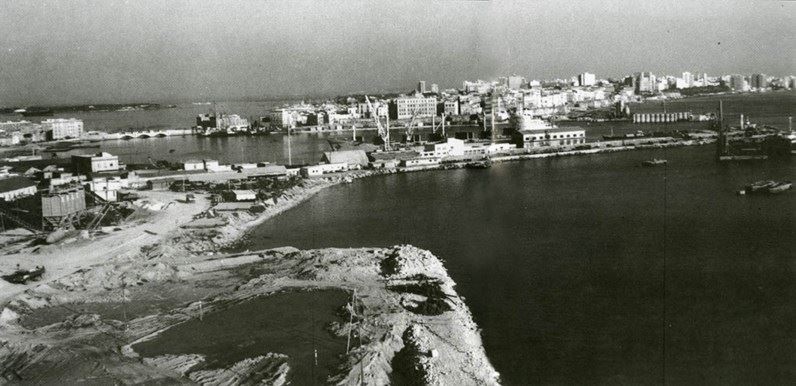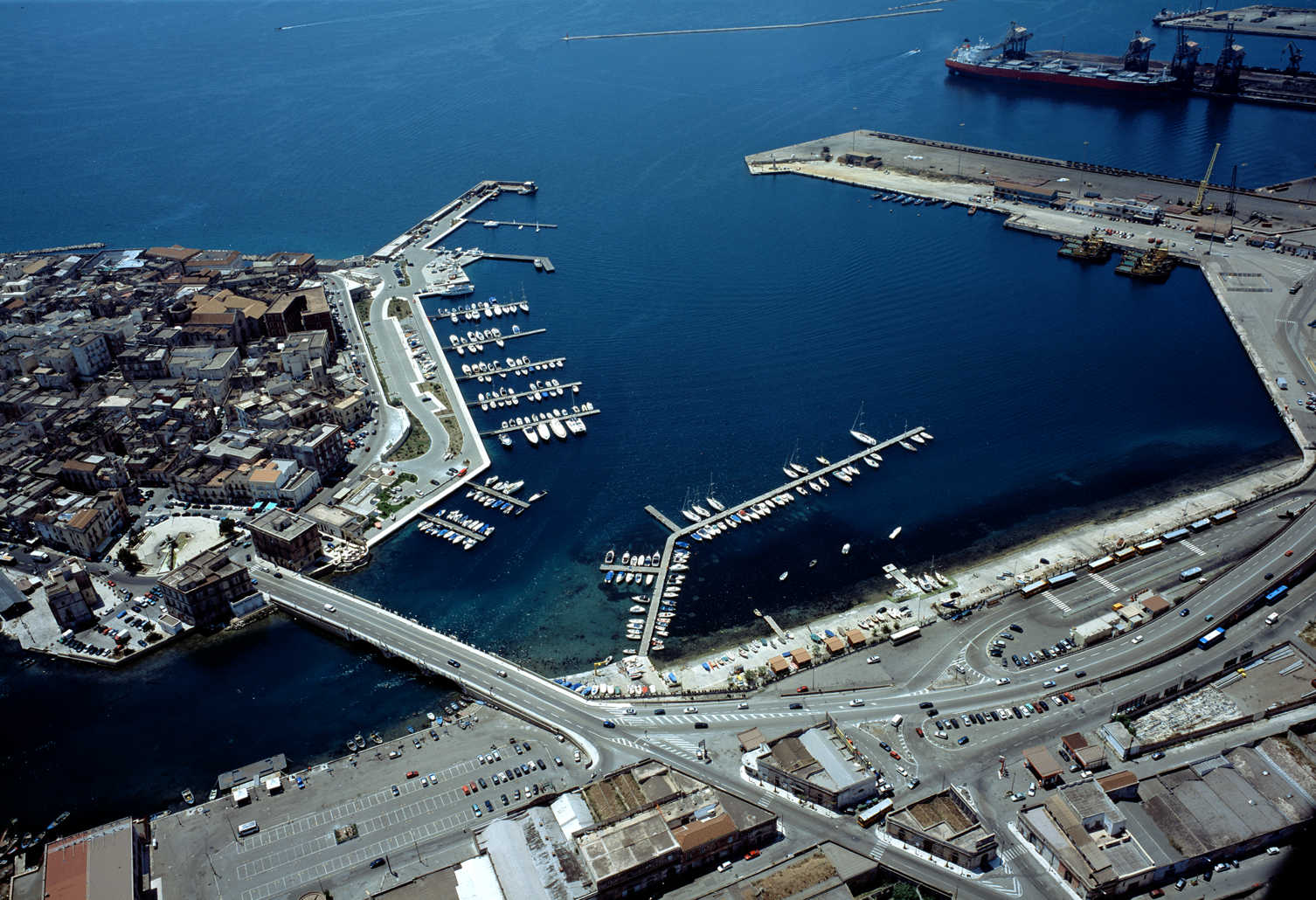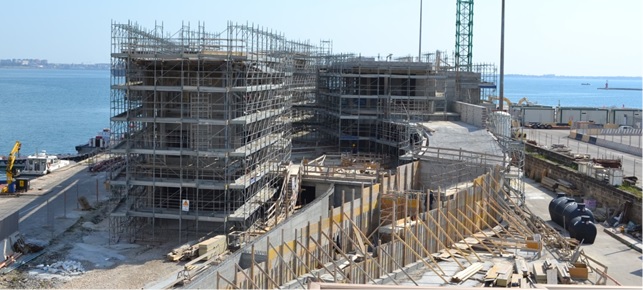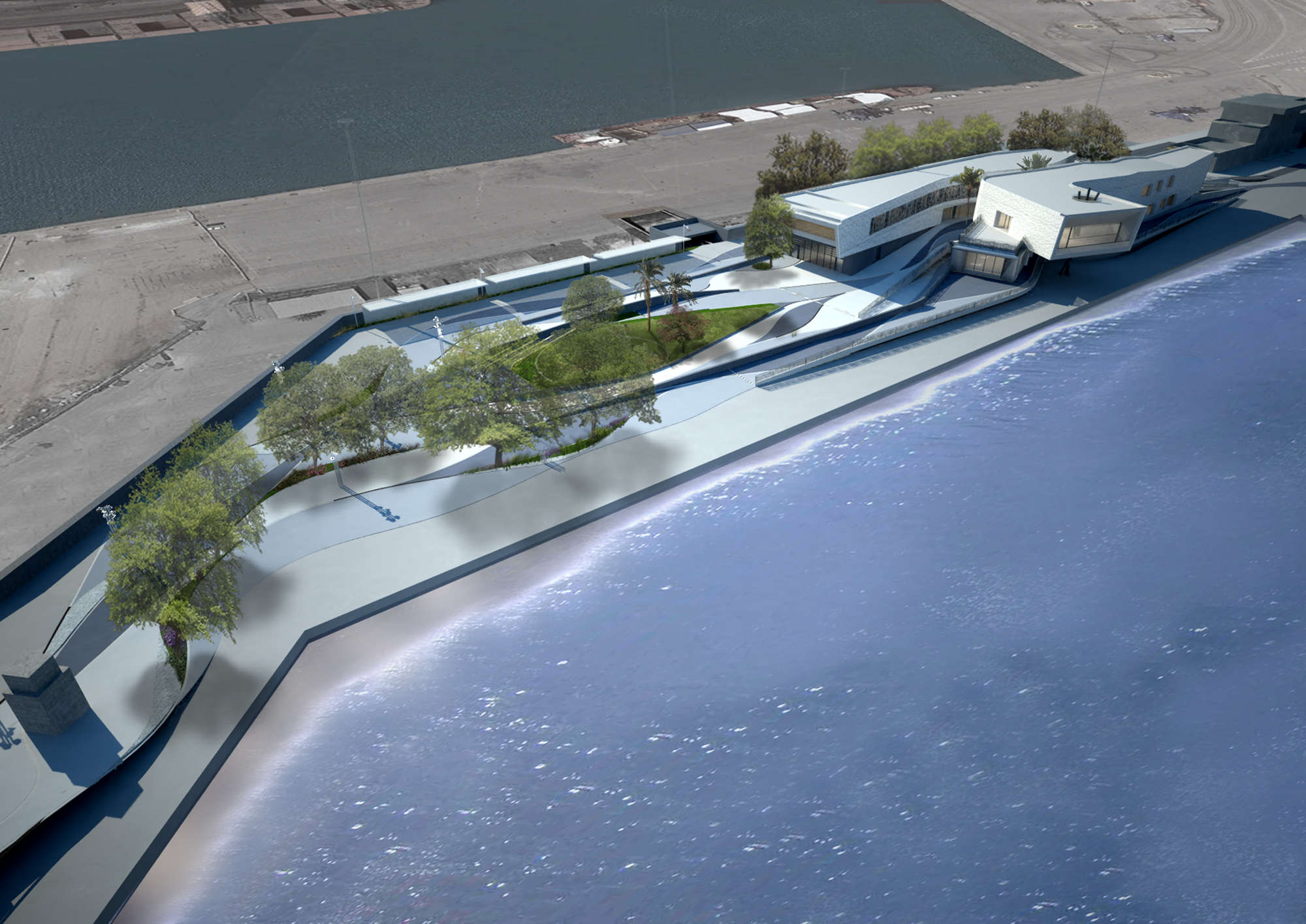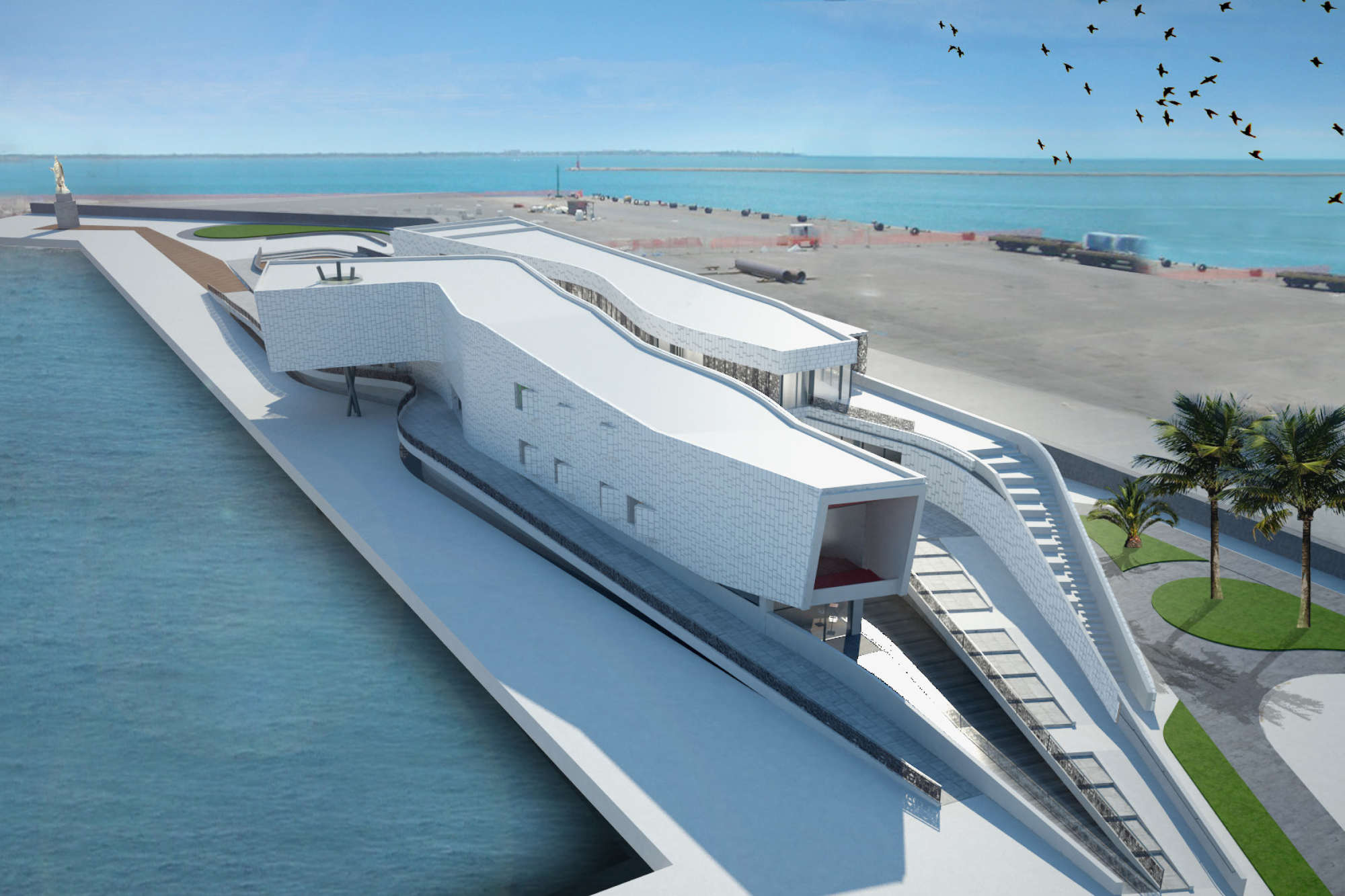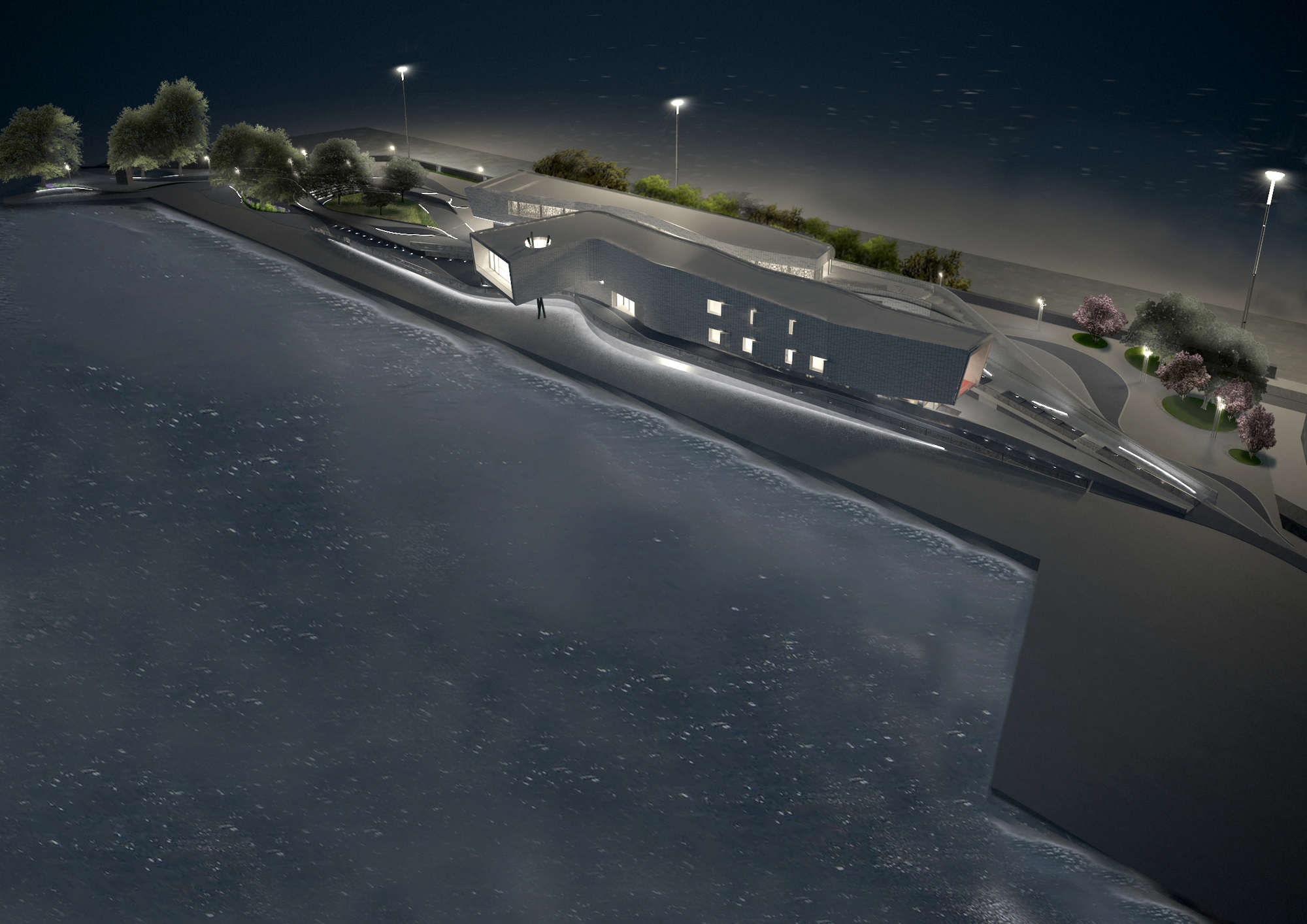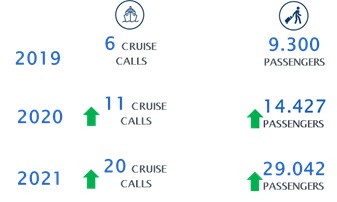The Port Network Authority of the Ionian Sea – Port of Taranto and the Municipality of Taranto have started a closer cooperation in order to strengthen the institutional relationship and achieve a common goal: to regenerate the city’s waterfront through a shared governance of a strategic and sustainable development plan. Therefore, the two Administrations have lined up their institutional missions and visions in order to pave the way for the realization of common activities that will change and reconnect the existing architectural and cultural relations between the port and the city. To this aim, the land-sea interfaces will evolve into crossroads of cultures and eventual hubs of commerce and trade, ensuring thereafter the general evolution of the city’s sea-based landscape and identity.
The key elements underlying the measures and strategic plans related to the city of Taranto mainly focus on the flourishing of projects and initiatives that can allow the transition from the “Old Taranto” – whose landscape and image has always been connected to industrial elements and environmental issues – to the “New Taranto”, the Sea Capital and Mediterranean sustainable tourism destination. Today, more than ever, Taranto needs to turn page to rethink its vocation as a port-city as many other EU port cities around the globe did over the decades while shifting their landscapes and urban waterfronts from industrial sites to hubs for leisure and cultural activities.
To this aim, the Port and the City agreed to cooperate in order to regenerate the urban waterfront and to achieve a land-sea renovation. Moreover, it should be considered that the aforementioned cooperation is part of a wider development plan for the comprehensive relaunch of the city of Taranto which involve several governance levels.
- The Italian Government is constantly supporting the regeneration of the city with the aim to develop projects capable of enhancing the quality of the Ionian citizens’ lives. The Institutional Development Contract [1] (CIS – Contratto Istituzionale di Sviluppo) is the wider measure, currently managed by the Italian Prime Minister, gathering financial aids – amounting to over 200 million euros – for a number of interventions aimed at strengthening the process of economic conversion of the entire Ionian area.
- The Puglia Region has also approved the “Taranto futuro prossimo” plan [2] whose aim is the regeneration of the city by promoting the full and comprehensive participation of all actors involved: from the Institutional bodies to private companies, local associations and citizens. The plan is a participatory process, aimed at planning and programming sustainable development and social, economic and cultural enhancement of the whole Taranto area.
- The general system of measures available at National and Regional level match with the local plans adopted and managed by the Port Network Authority with the Three-Year Operational Plan 2020-2022 [3] and by the Municipality of Taranto with “Ecosistema Taranto” that is the strategic plan for ecological, economic and energy transition adopted by the City to create positive impacts for a full cultural, environmental and tourism sustainable development.
- The New Port Master Plan [4] that is the main document tracing the cooperation between the two Public Administrations for the regeneration of the sea-land interface connecting the port of Taranto to the city’s Mother Island.
Context
Geography and economy
Located along the longest coastline in mainland Italy (Puglia region, Southern Italy), with a privileged position at the heart of the Mediterranean Sea, the port-city of Taranto opens its doors to a fairy-tale scenery, extremely rich in history, diversified economy, stunning coastal landscapes and deeply-rooted local traditions.
The geo-localization of the port-city of Taranto port-city, at the heart of the Mediterranean.
The port-city of Taranto is the chief-town of the namesake Province. It is the third largest continental city in southern Italy with a population of a little over 200,000. Taranto is largely a modern, industrial city that is now rapidly increasing its positioning also as emerging tourist destination and fruitful hub for cross-cultural industries and labs. However, steel and iron plants, oil refineries, chemical works, shipyards for building warships and food processing factories still remain an integral part of the economy and landscape of the city.
The evolution of the socio-economic system has traced the city’s development trajectory. Looking back to the 1960s, the economy of Taranto was traditionally based on shipping and trading as well as on the production of agricultural products especially in the inland areas (notably grapes, olives, vegetables). These main assets were rapidly expanded with the construction of a vast steelmaking plant (the former “Italsider” and “ILVA”, now “ArcelorMittal”, one of the largest plant in Europe, the first one in Italy), flanked by satellite industries such as chemicals, cement and mechanical engineering, together with smaller dependent companies. Fishing has always been a fairly consistent factor in the economy, together with related activities (fish processing).
The presence of the steel factory has marked the identity and architectural landscape of the city over the last decades thus obscuring the extreme beauties and cultural heritage of the port-city and hindering the development of sea-based activities capable of enhancing the maritime culture and identity of Taranto. The regeneration of the urban waterfront will allow to renovate the relation between the port and the city and to consider its maritime vocation as the main asset for a sustainable and innovative rebirth, thus contributing to the flourishing of new evolutions and dynamics.
Old view of Taranto waterfront.
The role of the Port
The Port of Taranto celebrates a glorious past. The city serves as the main Italian naval base (Navy) and its port has made the city a central figure in the military history of Italy. Indeed, it was the home port for the Italian naval fleet before and during World War I. In addition, it was the site of the World War II Battle of Taranto, initiated by British air attacks on the Regia Marina naval base in 1940. In 1943 it was part of Operation Slapstick, where British forces landed as part of the Allied invasion.
The Port is now characterized by a vivid present and green future as it is experiencing a period of exceptional change: in the framework of its global relaunch, the Port Network Authority of the Ionian Sea – that is the Port Managing Authority – is working on strengthening the role of Taranto in the Mediterranean area, in order to take advantage of the considerable and growing opportunities coming from an efficient and modern port infrastructure. To this aim, the Port is under a huge and deep “age of growth” driven by the determined will to shape and renew the image of the Port-city interface, as a new generation one: that is a modern, sustainable and competitive global hub fostered by new projects mainly based on innovation.
Taranto waterfront, aerial view.
The Port contributes to boost local economy thus making Taranto the ideal hub in the Med area for global maritime commercial trade. In addition, the strategic planning of the Port also provides for the regeneration of the port-city relations putting the maritime culture at the heart of a development plan. The Authority has set up a strategic vision to lay the foundation for a sustainable growth of all port works and activities to be achieved through a close cooperation with the Ionian cluster and floating community.
Today the main challenge of the Authority is to be and act towards the achievement if a new generation Port, that is the Port of the future. The aim is not only to increase traffic but also to renew and enhance the relationships with the territory and the city. The Port is the central hub for a Special Economic Zone and a Customs Free Zone and it is also developing its own innovation hub to help the acceleration of local maritime start-ups/scale-ups. These achievements will allow the Port to act as the engine and facilitator of new trade, entrepreneurial and employment activities, counting on the fruitful cooperation with local, national and international bodies and institutions.
The role of the Municipality
In the last two years the municipal government of Taranto has taken concrete steps to strategically address the city’s main vulnerabilities, starting with the economic dependence on its steelworks plant, which, despite shrinking production levels, is still the largest in Europe.
To bring about the environmental and socio-economic rebirth of the city, the municipal government has envisaged many ambitious urban transformations and worked to update or complete the planning instruments needed to implement them.
Considerable public funds have already been allocated to support the planned urban transformations, especially by the national and regional governments, as mentioned in the introduction. But the City government has also radically reorganized its own structure to make the participation of private partners and investors easy and convenient. The aim is to make of Taranto a resilient city, capable to promote an environmentally sound economic and energetic transition and to create an “Eco-system” of business opportunities (Ecosistema Taranto).
One of the pivots of this virtuous transition is the building of a new (and improved) relationship between the city, its port and the system of waterfronts that characterize Taranto’s geography. In this context, the redesign of the historic city-port interface, on which the Municipality and the Port Authority are working together, is particularly important, as it will contribute greatly to the overall regeneration of the Old Town (Città Vecchia), possibly Taranto’s most underused asset.
The Old Town stands on the site of ancient Taras, once the most powerful Greek colony in Italy, founded by the Spartans in the 8th century B.C. In its almost 3000 years of history, given its strategic position at the almost exact centre of the Mediterranean sea, the island was redeveloped many times for defensive, civil and commercial purposes. For this reason, the Old Town is also known as Isola Madre (mother island) of Taranto.
The Municipality is determined to regenerate, revamp and bring back life to the Old Town, after decades of relative neglect. Indeed, because of its artistic and historical value and its almost intact beauty, the Old Town is a potentially very attractive tourist destination and, as such, can play an important part in the strategic economic transition that Taranto is currently undergoing.
Redesigning the port-city landscape: the waterfront as a window to renew the port-city relationship
The port-city of Taranto is nowadays interested by a process of redefinition of its economic and cultural dimensions that, over the last decades, have been mainly focused on the industrial vocation of the local economy. Further to the crisis of the steel industry and the consequent instability of the local steel plant, local Administration are focusing their policies on strategic plans based on the redesigning and differentiation of both economic and productive activities, thus having to provide the city with more sustainable future perspectives.
The industrial framework of Taranto has influenced the perception of the city’s image and cultural approach both locally and globally. The city’s landscape has always been associated to the smokestacks of the factory thus contributing to associate the image of Taranto to negative and environmentally critical opinions and considerations, at the expense of the natural beauties and huge cultural heritage owned by the city.
To this aim, starting from the assumption that Taranto is a Sea capital of the Mediterranean Basin, its growth perspectives and its future need a regeneration push in order to put the Sea at the heart of a general strategy to renew port-city relationships.
The maritime culture is indeed the main element to create a bridge between the Port and its floating community. For centuries, ports and their cities developed hand in hand, the port generating prosperity for the city. Relationships between ports and cities have also evolved thus intensifying this challenging relationship.
To achieve this goal, the Port Network Authority of the Ionian Sea – Port of Taranto and the Municipality of Taranto agreed to share a collaborative governance for the programming and design of the redevelopment interventions aimed at regenerating the areas connecting the port to the city, starting from the urban waterfront.
The process includes both infrastructural/restoring works and the structuring of a new governance approach to open the port to the city thus creating a unique cultural and architectural promenade joining the two stretches overlooking the Great Sea.
The main documents and measures considered for the purpose of this paper are as follows:
- The agreement for the development of the Executive Urban Plan signed in December 2019 by the Port Network Authority of the Ionian Sea and the Municipality of Taranto;
- The Collaboration Agreement for the creation of a shared governance towards the planning and designing of the requalification actions of the areas connecting the sea-land interface of the city of Taranto signed by the Port Network Authority of the Ionian Sea and the Municipality of Taranto in May 2020;
- The set of projects and initiatives for the regeneration of the city-port waterfront and sea-land interfaces.
Towards the definition of the Executive Urban Plan
The city’s waterfront is one of the projects to be included in the Executive Urban Plan to be signed and adopted by the Port Authority and the Municipality of Taranto.
According to the institutional mission of the two Administration, they agreed to cooperate in order to implement the provisions included in the New Port Masterplan and the General Urban Development plan as far as the sea-land interfaces connecting the city to the port are concerned. To this aim, the two administrations have signed an Agreement in December 2019 to stigmatize the main activities to realize and their respective roles and commitment.
More specifically, the agreement include, among the realization of other works and projects – the so-called INT-1 area, covering the whole sea-land stretch connecting the San Cataldo Pier to the Aragonese Castle, including the Sant’Eligio Pier hosting the marina, with a capacity of 254 berths dedicated to boating.
The requalification of the waterfront plan: areas of intervention.
In 2015 the Port Network Authority entrusted to Prof. Rosario Pavia the realization of a Feasibility Study connected to the “Coastal protection, redevelopment and regeneration of the old city of Taranto overlooking the Great Sea” that was afterwards included in the list of interventions provided for by the Law Decree n. 1 of 05/01/2015 (also known as “Taranto Decree”).
In 2016, the project concerning the regeneration of the city’s waterfront – including the project for the renovation of the San Cataldo Pier – was awarded the “city planning” prize during “Urbanpromo”, that is the competition organized by the scientific journal of the National Urban Planning Institute. Considering the waterfront as “a strategy to regenerate the port-city relationship”, the Ionian port was classified among the winners in the category “Quality of infrastructures and public spaces“.
In 2019, the project was also presented during the open session “Il Waterfront come strategia di rigenerazione urbana e connessione Porto-Città” included in the programme of the Taranto Port Days 2019 [5].
Taranto Port Days 2019: Open Session about the regeneration of the Taranto waterfront.
The roadmap for the redevelopment of the sea-land areas of the port area, closer to the city (the Taranto dock and the sea-land interface of Corso Vittorio Emanuele up to the Castle) starts in 2009 with a design competition for the construction of the Multi-purpose service center at San Cataldo Pier. The winning proposal of the competition was the one presented by Professor Rosario Pavia, group leader of a group of professionals.
It should be highlighted that the island lies in a state of physical, social and environmental degradation; despite the geographical centrality and infrastructure, they are also urban parts isolated and separated from the surrounding territory.
The renovation project promotes the concept of waterfront as a complex infrastructural network according to the specific areas of interest: protection of coastal habitats, promenade paysagée, interaction between the port and city, preparation of a public space to be exploited and lived by the floating community of Taranto.
Project’s areas of intervention.
This implies the creation of a landscape and cultural promenade connecting the key places and areas of the old city bearing a deep emotional and cultural identity.
In the case of Taranto, the aim is not only to create a connection between places but to relate urban resources to the sea and the coast, thus enhancing in the one hand the architectural, archaeological, cultural building heritage and on the other hand the environmental and naturalistic heritage of the marine environment with its opportunities for culture, leisure, services for the city.
A shared governance for redesigning the sea-land interface of the port-city
The cooperation between the Port Network Authority and the Municipality of Taranto has been further strengthened by the Collaboration Agreement (under the Law n. 241/1990) signed in May 2020 that lays the foundations for the definition of a shared governance plan to achieve joint territorial development strategies. The regeneration of the city’s waterfront is the key strategy for the reconciliation of the port-city relationship as well as socio-economic, industrial, maritime, cultural, tourist/cruise development of the city of Taranto. The recovery and renovation of the sea-land interface between the port and the city, together with the activation of the Ionian Special Economic Zone, are set as the main driving forces for the relaunch of the city.
To achieve this goal, the two bodies agreed to cooperate in order to:
- support territorial development, in order to reconciliate the port of Taranto with the city;
- support territorial development following the strategies dictated and applied by EU, national and regional programming, thus sharing a local development plan also aimed at attracting national and international investors;
- share a common goal about the development of the port-city with particular attention to its economic growth, also through the development of the Ionian Special Economic Zone surrounding it;
- participate in the development of a territorial marketing and promotional plan oriented towards the relaunch of the tourism and cruise sectors.
The Falanto Port Service Center: a unique link between the Port and the city’s “Mother Island”
The set of measures adopted at national and local level are fully interconnected among them in order to combine the financial resources available and define a structured administrative monitoring and management of the infrastructural works already planned. Starting from the need to achieve a comprehensive regeneration of sea-land areas in the Mother Island of the city – the oldest area showing the highest level of urban degradation and negative industrial impact – there is an interwoven layer of projects that will significantly contribute to the regeneration of the city’s landscape.
The realization of a Multipurpose Service Centre is, indeed, a key element for the requalification of the port waterfront and a dominant project for the reconciliation of the city to the Port. The integration will be realized through a walk starting from the old town to the Saint Cataldo Pier.
More specifically, the project aims to set up a process of port waterfront requalification and city-port integration, thus creating a continuity between public spaces and pedestrian interconnections from the “Mother Island” – that is the old town – to the port. The name chosen for the Center is “Falanto Port Service Center” recalling the historical origins of the city linking Taranto to the ancient Greek city of Sparta. The history of Taranto is the history of its seafaring, of its port, which since ancient times has allowed the flourishing trade of goods and culture throughout the Mediterranean.
The “Falanto Port Service Center” will accommodate a cruise terminal providing passenger services and related activities. The Center will be built on the S. Cataldo Pier of the port of Taranto on a total area of 3.461,10 square meters (n. 2 buildings composed of three floors each) and will require a total investment of 6.632.660,00 Euro, covered by Port Network Authority’s own funds.
The Saint Cataldo Pier – East Side – is also under renovation with the aim to improve its functionality and to create a better interconnection with the Saint Eligio Pier (destined to yachting activities and already under concession) and the old town, both enriching the beauty and value of the city waterfront.
The building will be destined to the following activities:
- Cruise terminal/passenger services related activities;
- Port Network Authority’s offices;
- Promotional activities of the sea culture: multipurpose auditorium, conference room, spaces for exhibitions and educational activities;
- General meet&greet area: information point, public bodies representatives, relax area, bar, restaurants, restrooms, etc…).
The Falanto Port Service Center (as is).
The Falanto Port Service Center (to be).
The Falanto Port Service Center by night (to be).
The Falanto Port Service Center (to be).
The waterfront to boost cruise tourism
The port-city of Taranto is involved into the post-industrial revitalization of its waterfront aiming to fill the gaps originated by loosing of both economical activities and identity.
In this context, cruise tourism is considered as a possibility to diversify the port-city economy and to attract national and international investments. The change in the governance approach and the regeneration of the physical and infrastructural aspect of city’s waterfronts – from commercial ports to international cruise hub – can play an important role to canalize a cruise tourism growing trend.
A Marella cruise ship calling at the Port of Taranto.
A participatory strategy involving different actors – Municipality, Port Authority, Associations, schools and students, public and private organizations, etc. – is mandatory to create a city marketing approach capable of generating a shared city’s strategy for increasing the allure of a city as a tourism destination. To achieve this goal, the port-city of Taranto brought into play a coordinated set of actions aiming to expand the regenerative effects of change both in spatial, social and economic field.
Taranto is a young port in the cruise scene, an emerging destination boasting a privileged position in the heart of the Mediterranean Sea, as it is beautifully set along Puglia region, the longest coastline of any region in mainland Italy. Numbers from the last and the future cruise seasons – although the negative impact of the ongoing covid-19 emergency has led to the cancellation of 2020 calls – are thus confirming the “extraordinary” positive trend registered by the region in terms of incoming growth and arrivals from abroad.
Taranto cruise seasons: 2019, 2020, 2021. (Source: Port Network Authority of the Ionian Sea).
Thanks to the efforts of local authorities and associations which have strived to promote the city as a new destination during the last years, the tourism sector is growing with promising numbers, leveraging the cultural, historical and natural heritage the city is rich with. According to the data made available by the Regional Tourism observatory [6], both arrivals and presences in Taranto have registered an increase in 2019, with a +2% in the first semester.
The target is to pave the way for the future expansion of the sector and for the diversification of the local economy: to this aim, the Port Network Authority has decided to strongly invest in this sector in order to expand this kind of traffic and differentiate the general port traffic thus enhancing tourism activities and new opportunities for the relaunch of the port-city.
The Port Network Authority, co-working with the Municipality of Taranto, is also engaged in the massive opening to port culture and activities thus increasing awareness among citizens and institutions about the high values and resources related to the sea. The strategy is to strengthen the relationship between the port and the city thus investing in a new dress for the port-city waterfront as a common space for common people recognising themselves in the same place. To this aim, a new Port Exhibition Centre is going to be realised to become the place for bringing together ideas, innovation and port culture and history in a unique space overlooking the waterfront.
Furthermore, the Grottaglie “M. Arlotta” airport (20 km from Taranto) offers the possibility to develop fly&cruise packages as it is ready to operate charter flights and equipped for connecting Taranto to the rest of the world.
Conclusion
The regeneration of the urban waterfront in the Port-City of Taranto is a well-structured process involving a number of actors and actions to be taken at different levels. The cooperation between the Port-City Administrative Institutions has been analysed to show the strategy and the future development plans to be undertaken at local level.
The main result from this process will be the creation of a new cohesion between the port and the city. Taranto needs to leave behind large swathes of empty and blighted heavy industrial urban sites negatively affecting the city–port relationship and its perception among citizens and visitors. Over the last decades, these blighted, industrial waterfront areas remained abandoned until relatively recently actions started to change the mind and the approach of both institutions and citizens now demanding for their re-development into new innovative and regenerated areas capable of driving sustainable growth for local economy and culture. Taranto, as a port-city of the Mediterranean, is now looking forward to develop its urban waterfront and the general renovation of the whole Mother Island, that is the pulse in the evolution of the city’s cultural identity based on the sea.
As the history of many European city-ports tells – e.g. London, Hamburg, Rotterdam, and Amsterdam – such urban waterfront redevelopment projects can change the image and the mindset of a city. The case of Taranto is developing steadily and the city will soon have a dedicated open space to live, animate, promote and work by towards a greener and more sustainable future.
Notes
[1] The Law Decree 5 January 2015 (link: https://www.gazzettaufficiale.it/eli/id/2015/01/05/15G00005/sg), n. 1 converted with amendments into Law 4 March 2015, n. 20 to art. 5 (paragraph 1) has provided that the implementation of the functional interventions to solve the critical environmental, socio-economic and urban redevelopment situation, concerning the city and the neighboring areas of Taranto, is governed by a specific Institutional Development Contract.
[2] Link: http://www.tarantofuturoprossimo.eu/.Promoted by the Puglia Region with the Municipality of Taranto, developed with the support of ASSET, the Strategic Plan is a concertation tool, oriented towards environmental rehabilitation, economic diversification and production, sustainability.
[3] The three-year operational plan is the programmatic document of the port system authorities provided for by law 84/1994Link: http://www.port.taranto.it/attachments/article/1925/POT_2020-2022_f.to.pdf
[4] Link: http://www.port.taranto.it/index.php/it/pianificazione-e-governo-del-territorio
[5] Link: http://retedigital.com/italian-port-days-2019-rete-a-taranto-18-maggio-2019/
[6] Source: https://www.agenziapugliapromozione.it/portal/osservatorio-del-turismo
References
Autorità di Sistema Portuale del Mar Ionio – Porto di Taranto. www.port.taranto.it
Comune di Taranto. www.comune.taranto.it
Decree Law n. 1, of 5 January 2015, converted into Law n. 20, of 4 March 2015.
Deliberation of the Regional Council n.1384 of 23 July 2019 “Comune di Taranto. Nuovo Piano Regolatore Piano Regolatore del Porto. Variante al PRG ex art. 16 della L.R. 56/1980, Adeguamento alle prescrizioni della DGR 863/2018. Approvazione”.
CIS Taranto. cistaranto.coesionemezzogiorno.it
Law n. 84 of 28 January 1994. The Italian Port System Regulation.
Pigna, F.J. (2006). The City-Port Relationship: Its evolution, changing dynamics and challenges for port authorities.Partie I – Apports académiques (Chapitre 4), 77-92.
Osservatorio del turismo della Regione Puglia. www.agenziapugliapromozione.it
Head image: Port of Taranto. A panoramic view.
